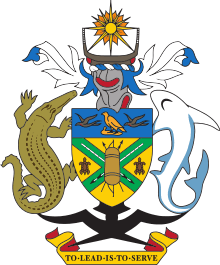Economy of the Solomon Islands
A per capita GDP of $3,200 ranks Solomon Islands as a lesser developed nation. Over 75% of its labour force is engaged in subsistence farming and fishing.
Economic history
Until 1998, when world prices for tropical timber fell steeply, timber was Solomon Islands main export product. In recent years, Solomon Islands forests were dangerously overexploited.
Solomon Islands was particularly hard hit by the Asian financial crisis even before the ethnic violence of June 2000. The Asian Development Bank estimates that the crash of the market for tropical timber reduced Solomon Island's GDP by between 15%-25%. About one-half of all jobs in the timber industry were lost. The government has said it will reform timber harvesting policies with the aim of resuming logging on a more sustainable basis.
In the wake of the ethnic violence in June 2000, exports of palm oil and gold ceased while exports of timber fell.
Economic sectors
..jpg)
Cash crops
Important cash crops and exports include copra and palm oil.
Gold
In 1998 gold production began at Gold Ridge on Guadalcanal.
Fishing
Exploitation of Solomon Islands rich fisheries offers the best prospect for further export and domestic economic expansion. A Japanese joint venture, Solomon Taiyo Ltd., which operated the only fish cannery in the country, closed in mid-2000 as a result of the ethnic disturbances. Though the plant has reopened under local management, the export of tuna has not resumed.
Tourism
Tourism, particularly diving, is an important service industry for Solomon Islands. Growth in tourism is hampered by lack of infrastructure, transportation limitations and security concerns.
Foreign aid
Since 2000 the Government of Solomon Islands has become increasingly insolvent. It has exhausted its borrowing capacity; in 2001 the deficit reached 8% of GDP. It is unable to meet bi-weekly payrolls and has become extraordinarily dependent on funds from foreign aid accounts, which provided an estimated 50% of government expenditure in 2001. Principal aid donors are Australia $247 Million per year (2006), New Zealand $14 Million per year (2004), the European Union, Japan $40 Million per year (2005), and the Republic of China (Taiwan) At least $20 Million per year .
The Solomon Islands are a member of the WTO.
Energy
Electricity - production: 78 GWh (2008 est.)
Electricity - consumption: 72.54 GWh (2008 est.)
Electricity - exports: 0 kWh (2009)
Electricity - imports: 0 kWh (2009)
A team of renewable energy developers working for the Pacific Islands Applied Geoscience Commission (SOPAC) and funded by the Renewable Energy and Energy Efficiency Partnership (REEEP), have hatched a scheme that enables these communities to access renewable energy, such as solar, without raising substantial sums of ready cash. If the islanders were not able to pay for solar lanterns with cash, reasoned the project developers, they can pay with crops [1]
Statistics
Economy - overview: GDP: purchasing power parity - $1.747 billion (2011 est.)
GDP - real growth rate: 9.3% (2011 est.)
Foreign Government Aid as a % of GDP: 40.125% (2006 est.)
GDP - per capita: purchasing power parity - $3,200 (2011 est.)
GDP - composition by sector:
agriculture: 37.7%
industry: 6.4%
services: 55.9% (2011 est.)
Population below poverty line: NA%
Household income or consumption by percentage share:
lowest 10%:
NA%
highest 10%:
NA%
Inflation rate (consumer prices): 10% (1999 est.)
Labor force: 202,500 (2007)
Labor force - by occupation: agriculture 75%, industry 5%, services 20% (2000 est.)
Unemployment rate: NA%
Budget:
revenues: $313.1 million
expenditures: $261.7 million, including capital expenditures of $0 (2011 est.)
Industries: fish (tuna), mining, timber
Industrial production growth rate: NA%
Agriculture - products: cocoa, coconuts, palm kernels, rice, potatoes, vegetables, fruit; cattle, pigs; fish; timber
Exports: $216.5 million (2010 est.)
Exports - commodities: timber, fish, palm oil, cocoa, copra
Exports - partners: China 54%, Australia 12.5%, Thailand 4.6% (2011)
Imports: $360.3 million (2010 est.)
Imports - commodities: food, plant and equipment, manufactured goods, fuels, chemicals
Imports - partners: Australia 27.3%, Singapore 26.4%, China 6.5%, Malaysia 5.1%, New Zealand 5.1% (2011)
Debt - external: $166 million (2004)
Currency: 1 Solomon Islands dollar (SI$) = 100 cents
Exchange rates: Solomon Islands dollars (SI$) per US$1 – 7.855 (2011), 8.07 (2010)
Fiscal year: calendar year
.jpg)
